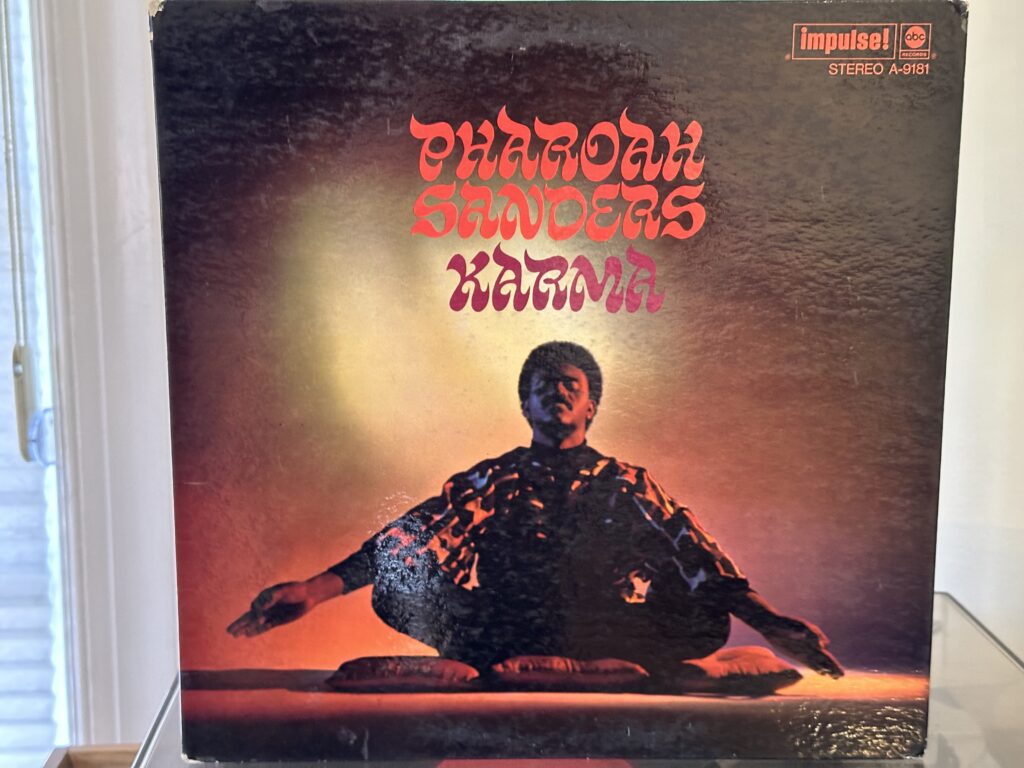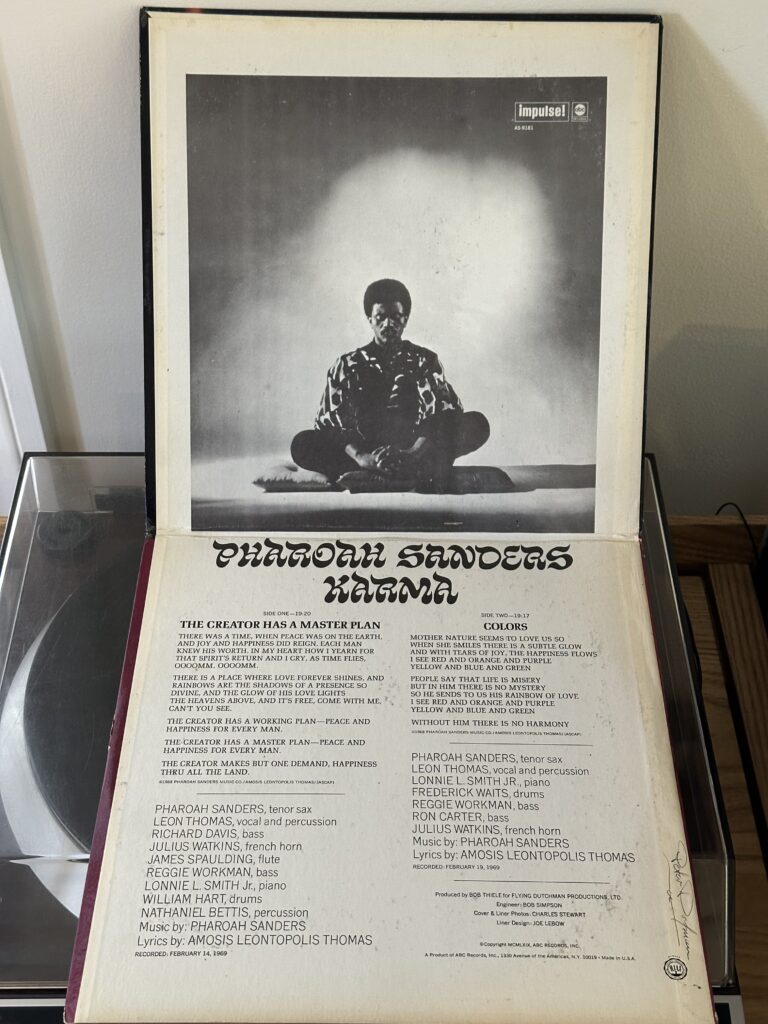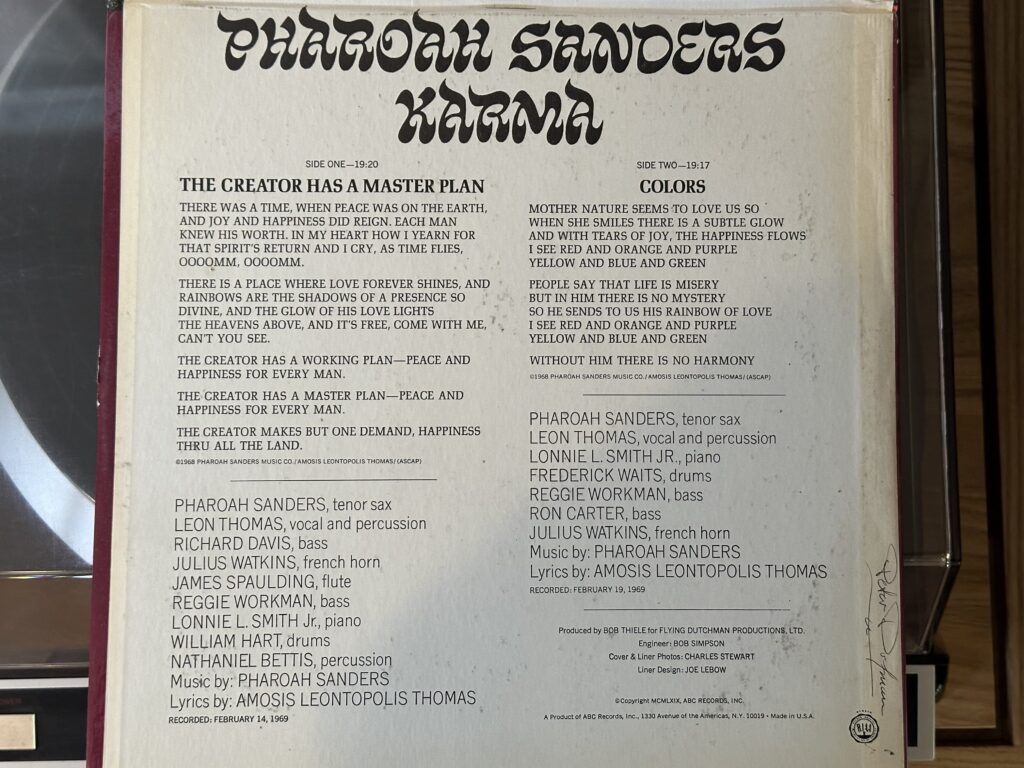
Album of the Week, April 20, 2024
Pharoah Sanders continued to work with John Coltrane following his appearance on the Seattle club performance that became A Love Supreme: Live in Seattle. The first released fruit of their collaboration was Ascension, then Meditations, Om, Kulu Se Mama, Expression and a host of live recordings. While working with Coltrane, though, he started his series of recordings for Impulse Records, beginning with the November 15, 1966 session that produced Tauhid. What followed, though, was nothing short of a hit, an almost album length performance that cemented the advances of A Love Supreme, adding additional types of percussion and making the vocals a feature, and essentially codifying the “spiritual jazz” genre.
It’s not clear that Sanders knew this was going to be the outcome when he entered the RCA Studio with Bob Thiele in New York on Valentine’s Day, 1969 to record the first session, “The Creator Has a Master Plan.” What is clear is that he had something in mind much broader than a traditional jazz quartet album. The players included Trane’s onetime bassist Reggie Workman, alongside second bassist Richard Davis; James Spaulding (previously heard on The All Seeing Eye and Schizophrenia) on flute; Julius Watkins, who had previously recorded with Trane on Africa/Brass, on French horn; the great Lonnie Liston Smith on piano; Billy Hart on drums; Nathaniel Bettis on percussion; and Leon Thomas on percussion and vocals. A second session five days later yielded the second track, “Colors,” and featured the same players minus Davis, Spaulding, Hart and Bettis, and adding Freddie Waits on drums.
Leon Thomas was a big part of the distinctiveness of the new sound. He had sung in more traditional ensembles in the early 1960s but was drafted in the early 1960s. When he returned from the service in the late 1960s, substantially weirder, he began working with Sanders on this record. His contributions included writing the poems for both tracks, singing them, adding miscellaneous percussion, and especially employing a distinctive yodel. The yodel had roots in ritual practice and in African Pygmy music; you can hear examples of the latter in the field recordings of Colin Turnbull.

“The Creator Has a Master Plan,” recorded during that first Valentine’s Day session, takes up the entirety of Side One plus half of Side Two. There have been only a few records I’ve reviewed where I feel you get a better sense of the composition by listening to the CD version, and this is one. Sanders’ vision ranges for more than 30 minutes across the two sides and signals its intent from the opening notes of the saxophone, which quote some of the progressions that Coltrane used in A Love Supreme. In this case, though, they’re played over a host of percussion, flute, and piano chords, and the modal darkness quickly gives way to a more hopeful chord as Spaulding’s flute twirls overhead.
The ensemble pauses, then the bass picks up the main theme. Again seemingly inspired by A Love Supreme, the theme is an eight-note pattern formed by two closely related motifs that stretch out over an octave before resolving back to the tonic (V-I-V-IX, V-I-V-VIII). The bass theme is accompanied by tuned percussion and by Lonnie Liston Smith strumming the strings of his piano like a harp. Spaulding picks up the theme in the flute, and Sanders finally enters, first playing pedal notes on the supertonic and tonic and then freely improvising in a major key over the open tuning of the theme. His tone is mostly ballad-smooth, but there’s a little brimstone around the edges. Smith’s piano primarily sticks to reinforcing the core chords, and Watkins’ French horn primarily provides supporting color. This beginning section of the work—call it Prologue and Part 1—proceeds for almost seven minutes and 30 seconds before Leon Thomas enters.
Thomas’s vocal and percussive part, like Trane’s chant on “A Love Supreme: Acknowledgement,” serves to kick the whole performance into a higher plane. He both provides the explicit message of the song and adds vocal color from multiple religious vocal traditions, including the aforementioned Zaire Pygmy people, gospel, and traditions even further afield. Thomas also plays hand percussion, further adding to the ceremonial overtones. This first section comes to an end with a restatement of the opening theme, now with greater passion and energy, as though the band was preparing to wrap up the performance.
But that doesn’t happen; instead, at 13 minutes, the bass theme and opening recapitulates as though beginning the work again. But this time, after about two and a half minutes of Sanders’ soloing, the tempo accelerates to double speed and the real Pentecostal hollering begins, starting with Sanders and spreading to Watkins, the basses, and finally Thomas, who takes a wordless solo that first emphasizes the melody and then moves beyond it, employing multi-octave effects, falsetto, and more. (There are stretches that echo some of the Moroccan and Egyptian street performances that Peter Gabriel sampled in his Passion soundtrack, for instance the vocal color that underpins from 0:05 – 0:23 of “It Is Accomplished.”) It’s so intense that the solo actually seems to be overdubbed in a few parts. It’s in this section, by the way, that the LP version inserts a side break, returning on side 2 to absolute chaos with every player blowing or striking their instrument at maximum volume, saturating the entire sound field and providing something akin to a vision of a multi-eyed, multi-faced, multi-winged fleet of seraphim. It’s not for the faint of heart or sensitive of hearing.
At the end of this section, Sanders reintroduces the faster theme and signals a return to tonality, but not to the more subdued meditation of the beginning. We are still transcendent beings by this point, a point he quickly reintroduces by overblowing to produce additional harmonics. Thomas’ solo returns to a more melodic yodel, this time accompanied by a sustained pedal note in the bass and French horn. Finally, 28+ minutes in, Sanders returns to the original theme and tempo and provides a final recapitulation of the opening theme along with the final statement of the poem by Thomas, going into a fadeout. A fadeout! After more than 32 minutes of straight performance! This band was going to keep playing all day.
After the onslaught of “Creator,” “Colors” comes as a meditative, though not exactly peaceful, coda. The opening statement from Sanders could almost have come from the opening theme of “Creator,” but instead of the insistent bass groove we get a field of bells, arco bass, flute and piano chords that provides a meditative bed for Thomas’ sung poem. Here he dispenses with the vocal pyrotechnics, providing a straight reading of the Creator as the source of the “rainbow of love.” Sanders blows one last run of the theme from the prelude of “Creator” under the final statements of the colors, then lets Spaulding have a final crack at the gentle melody before finishing with a last two note statement of the octave.

There is no such thing as a jaundiced listen to this music; it remains mind-blowing and repays close, repeated listening. Bob Thiele knew he had something big on his hands with this session, but had to convince the brass at ABC. He’s quoted as saying, “Until the record came out, it was the same tired tune: ‘What kind of crap is this? This isn’t going to sell; it doesn’t mean anything; it’s a lot of junk; you can’t dance to it; you can’t listen to it;’ ad infinitum.” But sell it did, and topped the Billboard Jazz chart for 12 straight weeks.
Like all good gospels, Karma recapitulated and honored what had come before while simultaneously marking the birth of something new. We’ll hear some of what followed in its wake next week.
You can listen to the album here:

PS: Another really good review of Karma by Josh Mound can be found on “The Best Version of…” in Audiophile Style.

This recoding is an essential track of my Life Soundtrack. I have listened to it countless times and always hear something new each time.
My husband and would sit on the floor in each others lap hugging throughout the play of this album. As he conveyed his thoughts about his music. I loved those memories. I truly miss him but his love endurer forever in my heart. Pharoah Sanders Wife and widow Tina Sanders.
This was an all time favorite Jazz album. RIP.